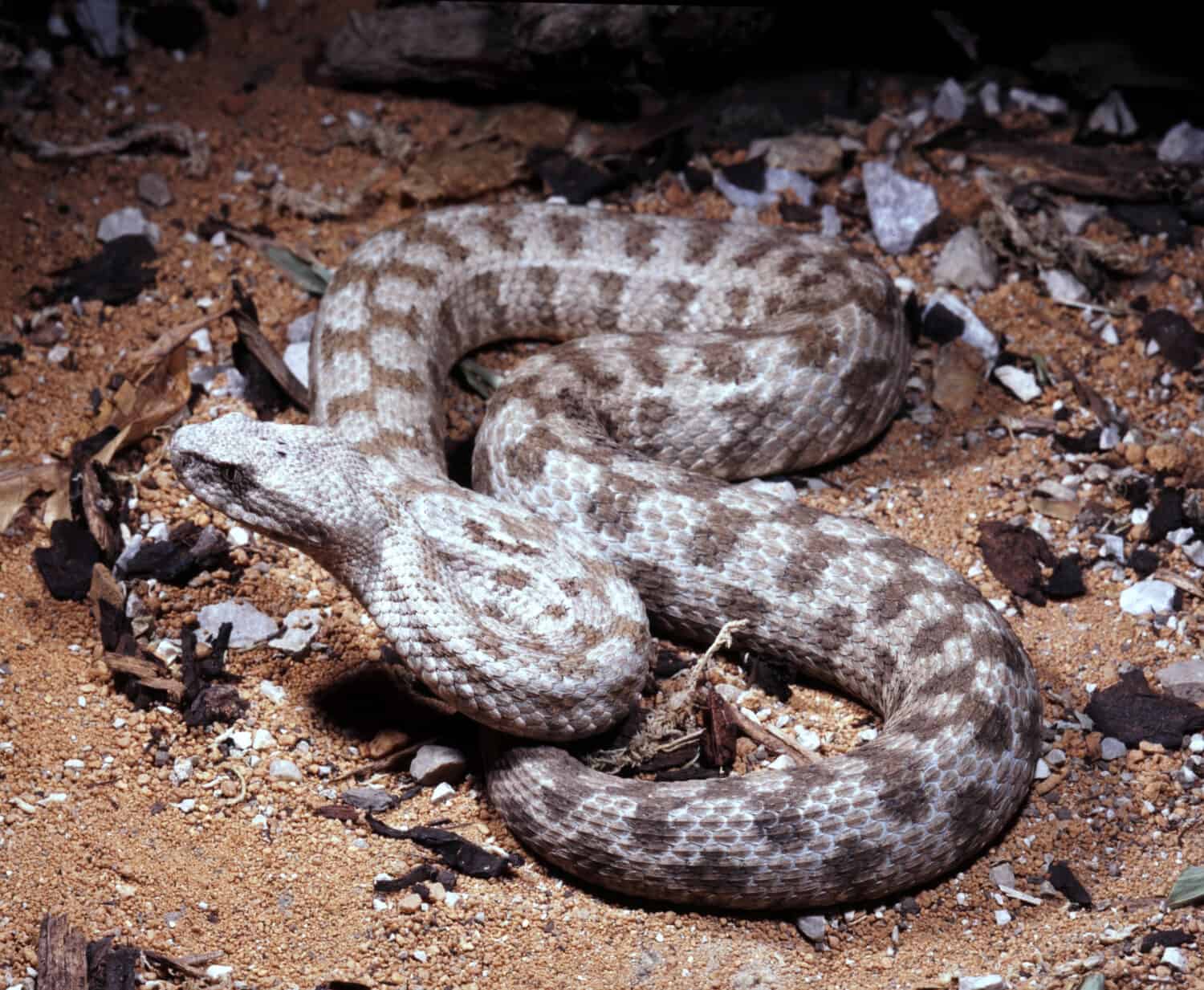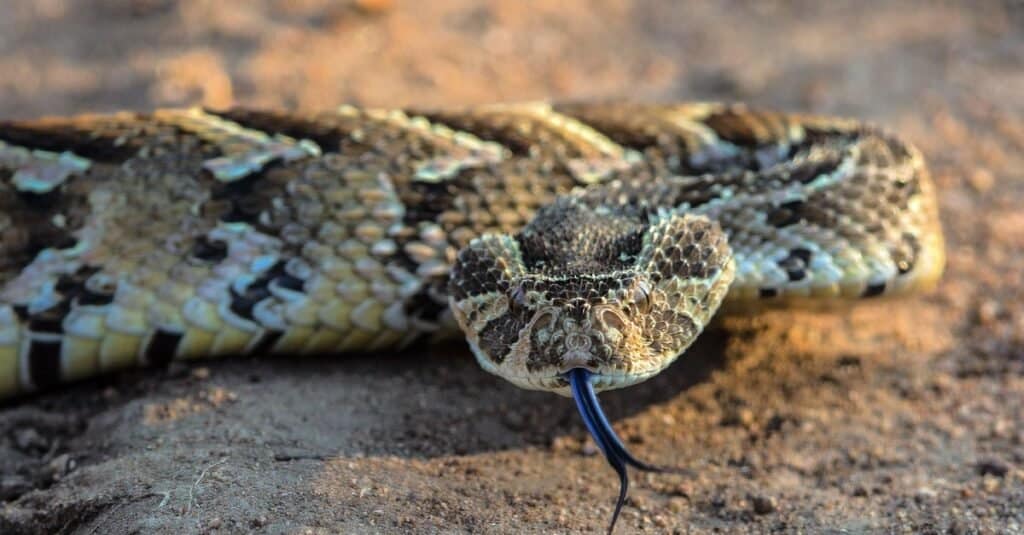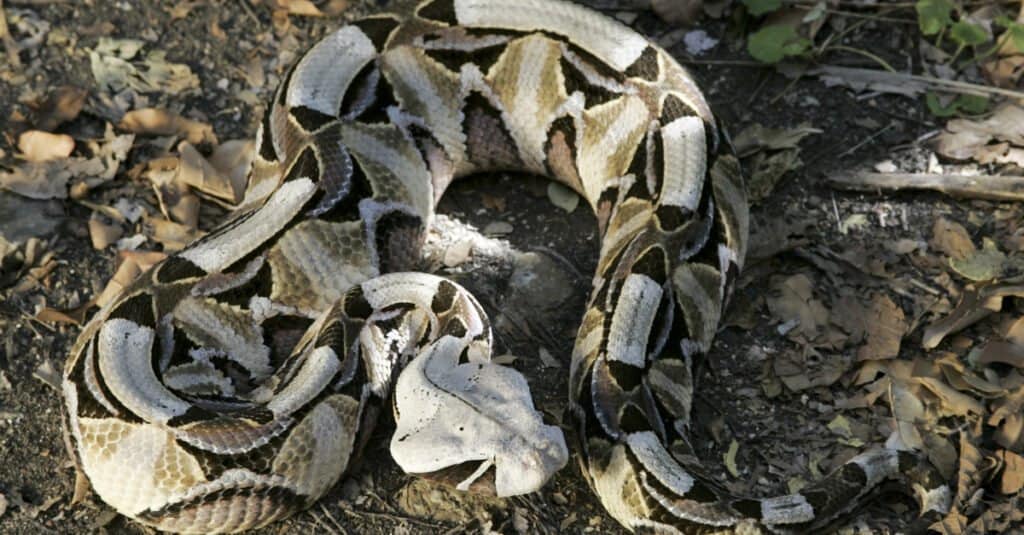Snakes are notoriously difficult to measure because they coil up, and their length actually changes! Often, it’s easiest to compare the snake’s size against more familiar items. Today, we’re comparing the size of a few vipers against some familiar objects.
While most of the world’s 4,000-plus snakes are harmless, some are extremely dangerous. Vipers are part of a really big family that scientists separate into two subfamilies, and from there, it gets split up even more. However, today we’re looking at snakes in the Viperinae subfamily, called true vipers or Old World vipers.
These snakes are all venomous; all of them have hollow, hinged fangs that flip forward and inject venom deeply into prey. Vipers run the gamut from small saw-scaled vipers and hairy bush vipers to common adders and butterfly vipers in looks and size. With variations like that, the next question might be — how big do these snakes get?
Most of them never get longer than three feet long and are far smaller than the New World pit vipers. However, a few exceptional species get bigger. Let’s explore the biggest Old World vipers in a size comparison!
Rock Viper (Montivipera xanthina)
Rock vipers live in humid habitats in northeastern Greece, several Greek & Turkish Islands, and mainland Turkey. They’re not as heavy-bodied as other vipers but achieve respectable sizes! These snakes have big, triangular heads and keeled scales. They also have markings on the top of their head that look like commas facing different directions. Rock vipers are colored gray, tan, brown, or pinkish with darker brown dorsal markings that form a slight zigzag shape. Like most vipers, its eyes have vertical pupils and a heavy scale over the eye that makes them look like someone put ketchup in their Cheerios.
These snakes are highly venomous, and several deaths have been reported as a result of their venom. Rock viper venom seems to be hemotoxic and cytotoxic, but until scientists do more research, that’s all they know.
A big snake, rock vipers average about 36 inches long (about three feet), but some on the islands get really big — up to 51 inches, or four feet, three inches. Compare this viper’s size against your typical four-foot-wide park bench — this snake is longer by three inches! They only weigh a few pounds, which is surprising because you’d expect a four-foot-long snake to weigh more, but snakes aren’t usually very heavy.

Rock vipers are highly venomous and one of the biggest vipers.
©Mike Manonas/Shutterstock.com
Blunt-Nosed Viper (Macrovipera lebetinus)
Blunt-nosed vipers are native to a narrow range from the eastern end of the Mediterranean Sea in Syria, Lebanon, and Turkey to southern Uzbekistan and northwestern Tajikistan. There are six subspecies currently, but the taxonomy is under review. A couple may be elevated to full species status in the near future, but nothing is certain yet.
These vipers have a head shaped like an arrowhead with a broken tip, a smallish neck, and a thick body. Their dorsal scales are heavily keeled and have a rough texture.
Their pattern is roughly lightning bolt-shaped darker brown blotches over a tan to gray base color. Blunt-nosed vipers are also called Levant vipers and are big snakes that often grow to five feet long.
How big is that? Imagine a snake as big around as the metal post holding up a chainlink fence that stretches across the hood of an F-150 pickup truck. That’s a big viper!

Blunt-nosed vipers aren’t well known, but they are big venomous snakes!
©Vladislav T. Jirousek/Shutterstock.com
Russell’s Viper (Daboia russelii)
Beautiful, but deadly. Russell’s vipers are responsible for many of the bites in and around the Indian subcontinent, where they are native. These snakes are highly venomous and have almost zero hesitation in biting perceived threats. Because they’re extremely willing to bite, people consider them aggressive. However, they’re probably more interested in finding food.
Aggressive or not, they’re responsible for as many as 80% of all venomous snakebites in Myanmar and 43% in India.
Russel’s vipers are covered in oval-shaped brownish markings outlined in black and sometimes white over their lighter base color. They have larger eyes and triangular heads with dark spots on the top. Although this species doesn’t get as thick and bulky as the next few snakes, Russel’s vipers get long — over five feet, or about 65 inches. In this viper size comparison, you’ll find these snakes almost as long as the average refrigerator is tall, which is usually six feet or 72 inches.

This venomous snake is one of India’s “Big Four” snakes that are responsible for the most bites.
©jaroslava V/Shutterstock.com
Puff Adder (Bitis arietans)
These snakes, native to most of sub-Saharan Africa, are responsible for many bites every year. It has a reputation for being aggressive, but most people find that it doesn’t hiss or strike when approached, only when stepped on or handled. Puff adders are ambush predators and even more reluctant to move out of the way than many other species. This trait, combined with their excellent camouflage, makes it easy to see why they get stepped on and bite people.
These snakes normally eat a variety of small mammals, including rats and mice. They’re not very active, and with their massive size, they don’t have to do much except sit and wait for prey. Puff adders are number two on our list because they are huge! One of the biggest individuals of this species was over six feet long and 16 inches around its widest point. As snakes go, it was heavy, weighing in at about 13 pounds. For comparison, stretch out an average six-foot-long dog leash — that huge puff adder was still longer by three inches. Then to get an idea of how big around it was, grab one of those big cardboard oatmeal cartons and try to stretch your hands around it — and you’d be close.

The puff adder, on average, is about three feet long, but rare specimens have reached 75 inches long, or six feet, three inches.
©iStock.com/S_Lew
Gaboon Viper (Bitis gabonica)
Perhaps best known as one of the fastest strikes in the snake world, Gaboon vipers are relatively sedentary. These snakes are native to coastal and montane forests and savanna in central and eastern Africa. Gaboon vipers are extremely venomous snakes that love basking along the edges of forests.
As dangerous as their venom is, they are just as calm. It makes them popular for first-time venomous snake keepers. Gaboon vipers are one of the heaviest and longest venomous snakes in the world, along with king cobras and eastern diamondback rattlesnakes. One really big Gaboon viper was caught in 1973. It was 70.8 inches long (5.9 feet) and weighed 25 pounds on an empty stomach. Another one caught and measured was a female that measured 69 inches long with a head 4.2 inches wide and was 14.65 inches around its widest point — as big around as a large cardboard oatmeal container. That snake weighed 19 pounds.
Some believe they might reach 81 inches long — compare the Gaboon viper’s size against the height of a typical doorway: the snake is almost as long as it is tall. Interestingly, they also have the longest fangs in the snake world, up to two inches long, almost as long as an average human’s pinkie finger.

Gaboon Viper (Bitis gabonica), on leaf litter. Its upper body is made up of beautiful diamonds, triangles, and hourglasses in neutral colors that mimic the colors of leaf litter.
©Stu Porter/Shutterstock.com
What Area Has the Biggest Viper?
The biggest of these vipers is the Gaboon viper, native to central and eastern Africa. Most vipers never exceed three feet long, and although they’re widespread across Europe, Africa, and parts of Asia, most aren’t outrageously venomous. That doesn’t mean they’re not dangerous, just that it’s probably not fatal if one bites you.
How to Stay Safe Around Vipers
Most vipers, indeed most snakes, avoid people. If they have time, they try to escape before a confrontation. Some are more willing to stand their ground, and that’s why they’re dangerous — they don’t move out of the way and get stepped on or too near accidentally.
The best way to stay safe is to stay vigilant and aware of your surroundings. Never place your feet or hands where you can’t see them, and never pick up a venomous snake without proper tools and training.
Biggest Pit Viper
This snake is a beast! Some people say that its skin feels like how you would expect a dragon’s skin to feel. The bushmaster is the longest viper in the world, but it’s a pit viper — one of the New World vipers that have heat-sensing pits that help them locate and strike prey even in the dark. Read on to learn more about the biggest pit viper ever recorded.
The photo featured at the top of this post is © Vladislav T. Jirousek/Shutterstock.com
Discover the "Monster" Snake 5X Bigger than an Anaconda
Every day A-Z Animals sends out some of the most incredible facts in the world from our free newsletter. Want to discover the 10 most beautiful snakes in the world, a "snake island" where you're never more than 3 feet from danger, or a "monster" snake 5X larger than an anaconda? Then sign up right now and you'll start receiving our daily newsletter absolutely free.
Thank you for reading! Have some feedback for us? Contact the AZ Animals editorial team.






